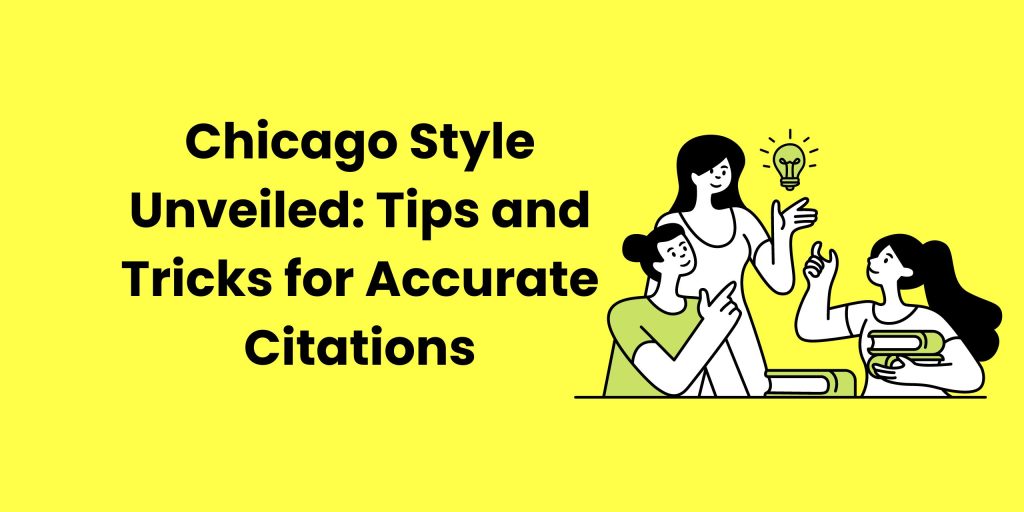Introduction:
Navigating citation styles can be challenging for students, but mastering them is essential for academic writing and research. One of the most widely used citation styles, particularly in history, literature, and the arts, is the Chicago Manual of Style (CMOS). Understanding the intricacies of Chicago style citations can elevate the quality of your academic work and ensure proper attribution of sources. In this comprehensive guide, we’ll unveil the Chicago style, offering tips, tricks, and examples to help students navigate the complexities of citation in academic writing.
- Understanding Chicago Style:
The Chicago Manual of Style is a comprehensive guide to writing, editing, and publishing in the humanities and social sciences. It offers two primary citation systems: the notes and bibliography (NB) system and the author-date (AD) system. The notes and bibliography system is commonly used in literature, history, and the arts, while the author-date system is prevalent in the sciences and social sciences. Key features of Chicago style include:
- Use of footnotes or endnotes for in-text citations.
- Detailed bibliographic entries in a separate bibliography or reference list.
- Flexible formatting options for different types of sources, including books, articles, websites, and multimedia.
- Basic Formatting Guidelines:
Before delving into specific citation examples, let’s review some basic formatting guidelines for Chicago style:
- Font and spacing: Use a legible font such as Times New Roman, size 12, and double-space the entire document.
- Margins: Set one-inch margins on all sides of the page.
- Title and heading: Include a centered title on the first page of your document, followed by your name, instructor’s name, course title, and date, each on a separate line and double-spaced.
- Page numbers: Number all pages consecutively in the upper right corner, one-half inch from the top and flush with the right margin.
- Citations in the Notes and Bibliography System:
In the notes and bibliography system, citations are indicated with superscript numbers in the text, which correspond to footnotes or endnotes containing the full citation information. The bibliography provides a detailed list of all sources cited in the text, arranged alphabetically by the author’s last name. Here’s how to cite common types of sources in the notes and bibliography system:
- Books:
In-text citation: ^1
Footnote/Endnote: Author’s First Name Last Name, Title of Book (Place of Publication: Publisher, Year), Page Number.
Bibliography: Last Name, First Name. Title of Book. Place of Publication: Publisher, Year. - Journal Articles:
In-text citation: ^2
Footnote/Endnote: Author’s First Name Last Name, “Title of Article,” Title of Journal Volume number, no. Issue number (Year): Page Range.
Bibliography: Last Name, First Name. “Title of Article.” Title of Journal Volume number, no. Issue number (Year): Page Range. - Websites:
In-text citation: ^3
Footnote/Endnote: Author’s First Name Last Name, “Title of Webpage,” Website Name, publication date or access date, URL.
Bibliography: Last Name, First Name. “Title of Webpage.” Website Name. Publication date or access date. URL.
- Citations in the Author-Date System:
In the author-date system, citations are included in parentheses within the text, consisting of the author’s last name and the publication year. A corresponding reference list is provided at the end of the document, listing all sources cited in alphabetical order by the author’s last name. Here’s how to cite common types of sources in the author-date system:
- Books:
In-text citation: (Author’s Last Name Year, Page Number)
Reference List: Last Name, First Name. Year. Title of Book. Place of Publication: Publisher. - Journal Articles:
In-text citation: (Author’s Last Name Year)
Reference List: Last Name, First Name. Year. “Title of Article.” Title of Journal Volume number, no. Issue number: Page Range. - Websites:
In-text citation: (Author’s Last Name Year)
Reference List: Last Name, First Name. Year. “Title of Webpage.” Website Name. URL.
- Tips for Accurate Citations:
- Familiarize yourself with the specific requirements and preferences of your instructor or publisher regarding citation style.
- Use reputable sources and verify information to ensure accuracy and reliability.
- Keep detailed records of your sources, including bibliographic information, to facilitate citation and avoid plagiarism.
- Consult the latest edition of the Chicago Manual of Style or online resources for guidance on specific citation formats and examples.
- Proofread your citations carefully to check for errors in formatting, punctuation, and citation details.
Conclusion:
Mastering Chicago style citations is essential for academic writing in the humanities and social sciences. By understanding the principles of Chicago style, adhering to formatting guidelines, and properly attributing sources, students can enhance the clarity, credibility, and professionalism of their academic work. Remember to consult the latest edition of the Chicago Manual of Style for comprehensive guidance and examples, and practice citing sources accurately and consistently. With diligence and attention to detail, students can navigate the complexities of Chicago style citations with confidence and precision in their academic endeavors.
